Big. Bold. Booming. Bass bodies form the main part of this low end instrument, and thus have a big impact on their overall feel. There are so many different body styles around these days, each with its own unique attributes and history. So, it’s well worth exploring bass bodies and the impact they can have on your playing experience (and aesthetic).
But where do you begin? With a huge range of brands and styles out there, it can be difficult to know where your style and taste fit in. Luckily, you’re about to find out all about bass bodies, so get comfortable, and discover the true beauty of these amazing hunks of wood.
How about a bit of history?
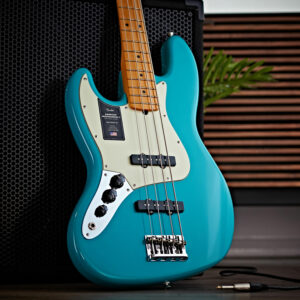 Where did it all begin? Electric basses as we know them have been around quite a while now, since the 1950s, to be exact (although upright electric basses were invented in the 1930s).
Where did it all begin? Electric basses as we know them have been around quite a while now, since the 1950s, to be exact (although upright electric basses were invented in the 1930s).
Leo Fender and George Fullerton, who spearheaded the electric guitar and bass revolution, created the now-legendary and still much-loved Precision Bass. This featured a smaller, more manageable body shape than its predecessor, the double bass.
As such, these new electric basses were much easier to transport and simple for guitarists to switch to if needed as they looked and felt like a larger electric guitar.
They could also be played and handled quite easily thanks to the cutaway body that offered effortless upper fret access. The Precision Bass was soon followed by the Jazz Bass in 1960, which featured an offset body and a different style of pickguard.
Gibson had also released their first bass in 1953 – the violin-like EB-1. This had an extendable pin which the player could use to prop it up from the bottom and play upright like the basses of old.
It would soon disappear from subsequent designs as the electric bass craze caught on, and a new breed of bass player was born – one that wasn’t afraid to pick up the instrument and get in the groove.
As time went by, more and more brands started releasing their own electric basses, and by the 1980s there was a whole plethora of body shapes and bass styles around. Fast forward to today and you can find virtually any body shape and material you like if you look hard enough.
Brand styles
There are plenty of different bass shapes to explore, some of which you will recognise, some you may not.
We’ve already briefly discussed the classic Fender basses, which laid the foundations for the basses of today. But things have certainly moved on since then, and there’s now a multitude of brands which offer their own unique take on the electric bass. Here’s a rundown of each:
Ibanez
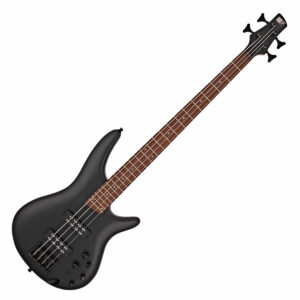 Known as the kings of rock and metal instruments, Ibanez’s basses are generally made to look mean and machinic.
Known as the kings of rock and metal instruments, Ibanez’s basses are generally made to look mean and machinic.
Their bodies often sport the famous double cutaway shape, whilst having plenty of funky finishes and humbuckers set into the wood. Some, like the S series, have a more rounded look, with slightly smoother horns, and others have a really sharp, menacing aesthetic.
The body materials range from mahogany and nyahtoh in the lower range basses to ash in the higher end models.
Gibson
Like Fender, Gibson is home to many iconic basses which you’ll no doubt recognise when you see them. From the legendary Thunderbird, which has a rounded body with a distinctive shape, to the sharper SG, which is one of Gibson’s most recognised shapes, there’s a lot of heritage here.
Rickenbacker
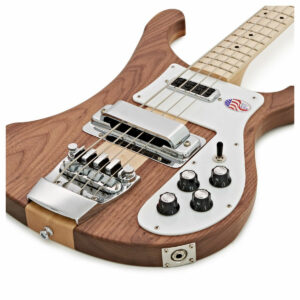 Decidedly distinctive. Famously used by the likes of Paul McCartney, as well as many other prominent artists, it’s fair to say Rickenbackers have left a fruitful legacy behind them.
Decidedly distinctive. Famously used by the likes of Paul McCartney, as well as many other prominent artists, it’s fair to say Rickenbackers have left a fruitful legacy behind them.
Their body shape is perhaps one of the more unique in the world of bass guitars, and serves as a real badge of honour.
Fender
We’ve already touched on this, but Fender basses are, of course, some of the most well known in the world.
Aside from the Precision Bass and Jazz Bass, they offer the famous offset-shaped Mustang and a host of acoustic basses.
There are many more brands you can look at as well, but the ones above showcase the main shapes which are out there today.
Solid, hollow, or semi-hollow?
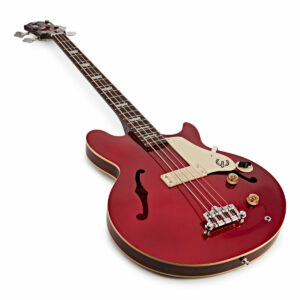 The eternal question. Each of these body types has its own unique properties.
The eternal question. Each of these body types has its own unique properties.
All basses before the advent of modern electric basses were hollow. The first solid-body (Precision bass) was partly designed to relieve one of the main issues which plagued the old upright hollow electric basses – feedback.
Feedback occurs when soundwaves get trapped inside the acoustic cavity and cause the wood and pickups to resonate – this creates a high-pitched ‘screeching’ or ‘droning’ sound (usually quite undesirable!).
Of course, some basses, like acoustics, have to be hollow, as they need a cavity for their sound to resonate from. However, there is a happy medium – the semi-hollow! These basses have a body which looks acoustic but has electronics and wood inside (as opposed to hollow bodies which are completely hollowed out).
This means semi-hollows avoid feedback issues whilst still having some acoustic properties and tone. They’re basically the best of both worlds. However, they don’t quite have the ultra-crisp, treble-heavy tone of a solid body, nor the rich warmth of a hollow body bass guitar. But there are still some great options out there.
As you might imagine, hollow and semi-hollow basses are also a fair bit lighter than their solid counterparts.
Would you like a bit about wood?
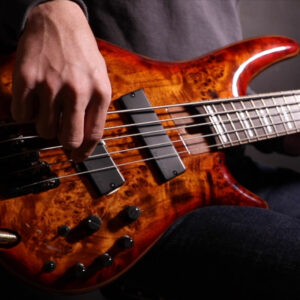 It’s quite important. After all, bass bodies are made from wood. Well, most of them. Now, when it comes to tone, wood is very important for acoustic basses – it will dictate how they sound.
It’s quite important. After all, bass bodies are made from wood. Well, most of them. Now, when it comes to tone, wood is very important for acoustic basses – it will dictate how they sound.
Maple, for instance, has a brighter tone, with more focus on the midrange and treble frequencies. Mahogany, on the other hand, emphasises the lows more, adding warmth and depth to your sound.
The tone of electric basses, however, is barely affected by the tonewood at all. This is because the sound is generated by the pickups, which translate the vibrations of your metal strings into an electric signal and through to an amplifier.
That being said, some woods, like basswood, are used because they’re lightweight or because they add a heavy, stable feel to the instrument.
There are loads of tonewoods to choose from when it comes to electric bass bodies, with some of the most popular being mahogany, basswood, ash, alder, and bubinga.
And let’s not forget basses with beautiful quilt maple and poplar burl tops! These make for some of the most stunning aesthetics you’ll ever see.
How important is a bass’ body?
The main function of a bass body is to make you look badass. It’s for aesthetics. But a good bass guitar will generally always be well balanced too, and not tip one way or the other when strapped to your body.
With so many shapes and sizes to choose from, the world is your oyster, and you can really strike a pose onstage with the right body. And then there’s the body finish, which will add some serious flair and pizazz to your instrument!
Find out more
So, there you have it, electric bass guitar bodies explained. Hopefully this will help to guide you if you’re thinking about buying a bass guitar, but remember, the body is just the start. It’s the pickups and electronics in general that control the sound, whilst the neck and fretboard contribute to playability.
And, of course, there’s much more to a bass guitar than its body. Check out some of the other parts and spares which make up this beautiful instrument.



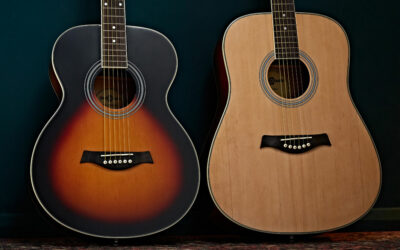

0 Comments